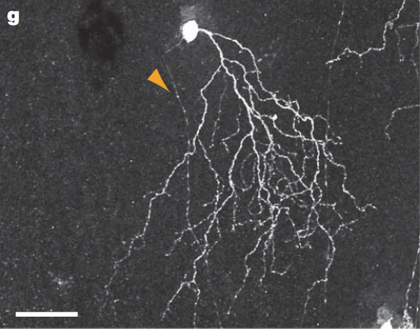Difference between revisions of "Dendrite"
From Eyewire
m |
(Marked this version for translation) |
||
| Line 1: | Line 1: | ||
<translate> | <translate> | ||
| + | <!--T:1--> | ||
Dendrites are the projections form a neuron's cell body that act to receive electrochemical signals from other neurons. | Dendrites are the projections form a neuron's cell body that act to receive electrochemical signals from other neurons. | ||
| − | == Dendritic Arbor == | + | == Dendritic Arbor == <!--T:2--> |
[[Image:jamb010_side.png|thumb|right|420px|A side view of a JAM-B cell showing the asymmetrical dendritic field.<ref name="kim2008" />]] | [[Image:jamb010_side.png|thumb|right|420px|A side view of a JAM-B cell showing the asymmetrical dendritic field.<ref name="kim2008" />]] | ||
The dendrites of a neuron are thin and branch often, close to the cell body. Based on the specific pattern of the dendrites branching, or a neuron's dendritic arbor, neuroscientists are able to classify the neuron. [[JAM-B Cell| JAM-B cells]] a particularly notable example of how a cell's dendritic arbor can be used to identify a cell. In about 85% of JAM-B cells, there exists a marked asymmetry in the dendritic arbor.<ref name="kim2008">In-Jung Kim et al. [http://hebb.mit.edu/courses/connectomics/Kim%20molecular%20identification%20retinal%20cell%20type%20upward%20motion%2008.pdf Molecular identification of a retinal cell type that responds to upward motion] (2008). Nature <strong>452</strong>: 478-482</ref> | The dendrites of a neuron are thin and branch often, close to the cell body. Based on the specific pattern of the dendrites branching, or a neuron's dendritic arbor, neuroscientists are able to classify the neuron. [[JAM-B Cell| JAM-B cells]] a particularly notable example of how a cell's dendritic arbor can be used to identify a cell. In about 85% of JAM-B cells, there exists a marked asymmetry in the dendritic arbor.<ref name="kim2008">In-Jung Kim et al. [http://hebb.mit.edu/courses/connectomics/Kim%20molecular%20identification%20retinal%20cell%20type%20upward%20motion%2008.pdf Molecular identification of a retinal cell type that responds to upward motion] (2008). Nature <strong>452</strong>: 478-482</ref> | ||
| − | ==References== | + | ==References== <!--T:3--> |
<references /> | <references /> | ||
</translate> | </translate> | ||
Latest revision as of 16:02, 17 November 2015
Dendrites are the projections form a neuron's cell body that act to receive electrochemical signals from other neurons.
Dendritic Arbor

A side view of a JAM-B cell showing the asymmetrical dendritic field.[1]
The dendrites of a neuron are thin and branch often, close to the cell body. Based on the specific pattern of the dendrites branching, or a neuron's dendritic arbor, neuroscientists are able to classify the neuron. JAM-B cells a particularly notable example of how a cell's dendritic arbor can be used to identify a cell. In about 85% of JAM-B cells, there exists a marked asymmetry in the dendritic arbor.[1]
References
- ↑ 1.0 1.1 In-Jung Kim et al. Molecular identification of a retinal cell type that responds to upward motion (2008). Nature 452: 478-482